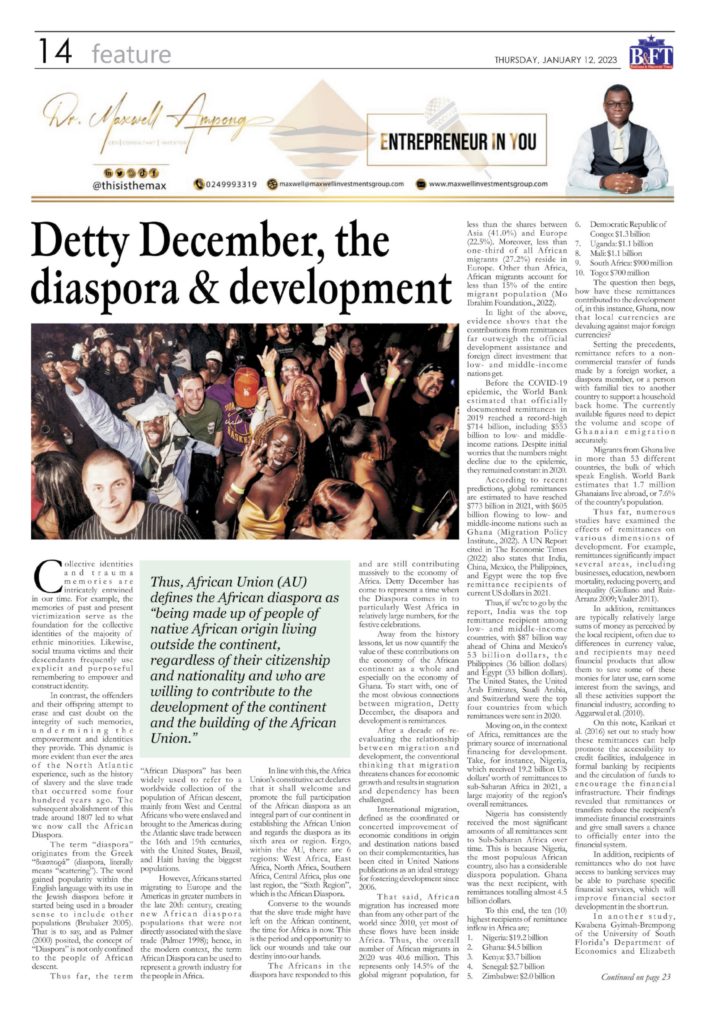
Collective identities and trauma memories are intricately entwined in our time. For example, the memories of past and present victimization serve as the foundation for the collective identities of the majority of ethnic minorities. Likewise, social trauma victims and their descendants frequently use explicit and purposeful remembering to empower and construct identity.
In contrast, the offenders and their offspring attempt to erase and cast doubt on the integrity of such memories, undermining the empowerment and identities they provide. This dynamic is more evident than ever in the North Atlantic experience, such as the history of slavery and the slave trade that occurred some four hundred years ago. The subsequent abolishment of this trade around 1807 led to what we now call the African Diaspora.
The term “diaspora” originates from the Greek “διασπορά” (Diaspora, literally means “scattering”). The word gained popularity within the English language with its use in the Jewish Diaspora before it started being used in a broader sense to include other populations (Brubaker 2005). That is to say, and as Palmer (2000) posited, the concept of “Diaspora” is not only confined to the people of African descent.
Thus far, the term “African Diaspora” has been widely used to refer to a worldwide collection of the population of African descent, mainly from West and Central Africans who were enslaved and brought to the Americas during the Atlantic slave trade between the 16th and 19th centuries, with the United States, Brazil, and Haiti having the biggest populations.
However, Africans started migrating to Europe and the Americas in greater numbers in the late 20th century, creating new African diaspora populations that were not directly associated with the slave trade (Palmer 1998); hence, in the modern context, the term African Diaspora can be used to represent a growth industry for the people in Africa.
Thus, African Union (AU) defines the African Diaspora as “people of native African origin living outside the continent, regardless of their citizenship and nationality and who are willing to contribute to the continent’s development and the building of the African Union.”
In line with this, the Africa Union’s constitutive act declares that it shall welcome and promote the full participation of the African Diaspora as an integral part of our continent in establishing the African Union and regards the Diaspora as its sixth area or region. Ergo, within the AU, there are six (6) regions: West Africa, East Africa, North Africa, Southern Africa, Central Africa, plus one last region, the “Sixth Region”, which is the African Diaspora.
Converse to the wounds that the slave trade might have left on the African continent, the time for Africa is now. This is the period and opportunity to lick our wounds and take our destiny into our hands.
The Africans in the Diaspora have responded to this and are still contributing massively to the economy of Africa. Detty December has come to represent a time when the Diaspora comes into particularly West Africa in relatively large numbers for festive celebrations.
Away from the history lessons, let us now quantify the value of these contributions on the economy of the African continent as a whole and especially on the economy of Ghana. One of the most obvious connections between migration, Detty December, the Diaspora and development is remittances.
After a decade of re-evaluating the relationship between migration and development, the conventional thinking that migration threatens chances for economic growth and results in stagnation and dependency has been challenged.
International migration, defined as the coordinated or concerted improvement of economic conditions in origin and destination nations based on their complementarities, has been cited in United Nations publications as an ideal strategy for fostering development since 2006.
That said, African migration has increased more than from any other part of the world since 2010, yet most of these flows have been inside Africa. Thus, the overall number of African migrants in 2020 was 40.6 million. This represents only 14.5% of the global migrant population, far less than the shares between Asia (41.0%) and Europe (22.5%). Moreover, less than one-third of all African migrants (27.2%) reside in Europe. Other than Africa, African migrants account for less than 15% of the entire migrant population (Mo Ibrahim Foundation., 2022).
In light of the above, evidence shows that the contributions from remittances far outweigh the official development assistance and foreign direct investment that low- and middle-income nations get.
Before the COVID-19 epidemic, the World Bank estimated that officially documented remittances in 2019 reached a record-high $714 billion, including $553 billion to low- and middle-income nations. Despite initial worries that the numbers might decline due to the epidemic, they remained constant in 2020.
According to recent predictions, global remittances are estimated to have reached $773 billion in 2021, with $605 billion flowing to low- and middle-income nations such as Ghana (Migration Policy Institute., 2022). A UN Report cited in The Economic Times (2022) also states that India, China, Mexico, the Philippines, and Egypt were the top five remittance recipients of current US dollars in 2021.
Thus, if we’re to go by the report, India was the top remittance recipient among low- and middle-income countries, with $87 billion way ahead of China and Mexico’s 53 billion dollars, the Philippines (36 billion dollars) and Egypt (33 billion dollars). The United States, the United Arab Emirates, Saudi Arabia, and Switzerland were the top four countries from which remittances were sent in 2020.
Moving on, in the context of Africa, remittances are the primary source of international financing for development. Take, for instance, Nigeria, which received 19.2 billion US dollars’ worth of remittances to sub-Saharan Africa in 2021, a large majority of the region’s overall remittances.
Nigeria has consistently received the most significant amounts of all remittances sent to Sub-Saharan Africa over time. This is because Nigeria, the most populous African country, also has a considerable diaspora population. Ghana was the next recipient, with remittances totalling almost 4.5 billion dollars.
To this end, the ten (10) highest recipients of remittance inflow in Africa are;
1. Nigeria: $19.2 billion
2. Ghana: $4.5 billion
3. Kenya: $3.7 billion
4. Senegal: $2.7 billion
5. Zimbabwe: $2.0 billion
6. Democratic Republic of Congo: $1.3 billion
7. Uganda: $1.1 billion
8. Mali: $1.1 billion
9. South Africa: $900 million
10. Togo: $700 million
The question then begs, how have these remittances contributed to the development of, in this instance, Ghana, now that local currencies are devaluing against major foreign currencies?
Setting the precedents, remittance refers to a non-commercial transfer of funds made by a foreign worker, a diaspora member, or a person with familial ties to another country to support a household back homeTherefore, the currently available figures need to depict the volume and scope of Ghanaian emigration accurately.
Migrants from Ghana live in more than 53 different countries, most of which speak English. World Bank estimates that 1.7 million Ghanaians live abroad, or 7.6% of the country’s population.
Thus far, numerous studies have examined the effects of remittances on various dimensions of development. For example, remittances significantly impact several areas, including businesses, education, newborn mortality, reducing poverty, and inequality (Giuliano and Ruiz-Arranz 2009; Vaaler 2011).
In addition, remittances are typically relatively large sums of money as perceived by the local recipient, often due to differences in currency value. Recipients may need financial products to save money for later use and earn interest from the savings. According to Aggarwal et al. (2010), all these activities support the financial industry.
On this note, Karikari et al. (2016) set out to study how these remittances can help promote the accessibility to credit facilities, indulgence in formal banking by recipients and the circulation of funds to encourage the financial infrastructure. Their findings revealed that remittances or transfers reduce the recipient’s immediate financial constraints and give small savers a chance to enter the financial system officially.
In addition, recipients of remittances who do not have access to banking services may be able to purchase specific financial services, which will improve financial sector development in the short run.
In another study, Kwabena Gyimah-Brempong of the University of South Florida’s Department of Economics and Elizabeth Asiedu of the University of Kansas’ Department of Economics delivered research on the impact of remittances on Ghanaian households. They concurred that international remittances enhanced Ghanaian households’ living standards to the point that they helped such families avoid poverty.
Remittances also help to build human capital at the home level. According to the report, those that received remittances sent their children to receive primary and even secondary education. Thus, remittances would have a long-term impact if recipient families could save some money to invest.
To sum everything up, leveraging the Diaspora’s numerous contributions as remittance senders, investors, philanthropists, innovators, exportable labour, and early adopters in the development of vital industries like tourism, health, and human capital may help Ghana wean itself off of its dependence on aid and development financing, which are dwindling from developed nations.
For instance, remittances or money returned home by citizens who reside abroad are highly beneficial to an economy because they reduce foreign exchange shortages and the balance of payment deficits without necessarily having to raise imports, according to Page and Mercer (2012).
Remittances complement household incomes in the recipient countries and, on occasion, help provide the cash required for small-scale business operations in developing nations (Coppola, 2020).
In 2021 Ghana received $4.5 billion worth of monies by way of remittance. Juxtapose this value with the current rate of the cedi to the dollar then we can begin to comprehend the immense opportunity that lies before us via movements like Detty December, increasing Diaspora activities within the local communities, and their contributions to development.
♕ —- ♕ —- ♕ —- ♕ —- ♕ —- ♕ —- ♕ —- ♕ —- ♕
References
Bonsu, C. O., & Muzindutsi, P.-F. (2017). Macroeconomic determinants of household consumption expenditure in Ghana: A multivariate cointegration approach. International Journal of Economics and Financial Issues, 7(4), 737-745.Available at: https://doi.org/10.3390/economies7040096
Ghana’s Ministry of Foreign affairs and Regional Integration. (2016). Diaspora Engagement Initiative of the Ministry of Foreign Affairs and Regional Integration. Retrieved from https://ghanaemberlin.de/wp-content/uploads/2019/12/DAB_CONCEPT_PAPER.pdf
Giuliano P, Ruiz-Arranz M (2009) Remittances, financial development, and growth. J Dev Econ 90:144–152Karikari, Nana Kwasi; Mensah, Sam; Harvey, Simon K. (2016). Do remittances promote financial development in Africa? SpringerPlus, 5(1), 1011–. doi:10.1186/s40064-016-2658-7
Migration Policy Institute tabulations of data from the KNOMAD/World Bank Prospects Group. Annual Remittance Data (May 2022 update). Available here: www.knomad.org/data/remittances.
Mo Ibrahim Foundation (2022). Africa and Europe; Facts and figures on Africa Migration. Retrieved from https://mo.ibrahim.foundation/sites/default/files/2022-02/aef_summit_african-migrations.pdf
Palmer, C. A. (1998). Defining and studying the modern African diaspora | Perspectives on history | AHA. Retrieved from https://www.historians.org/research-and-publications/perspectives-on-history/september-1998/defining-and-studying-the-modern-african-diaspora
Palmer, C. A. (2000). Defining and studying the modern African diaspora. The Journal of Negro History, 85(1-2), 27-32.
Perez-Saiz, H., Dridi, M. J., Gursoy, T., & Bari, M. (2019). The impact of remittances on economic activity: The importance of sectoral linkages: International Monetary Fund
Pier M. Larson (1999). African and American Atlantic Worlds || Reconsidering Trauma, Identity, and the African Diaspora: Enslavement and Historical Memory in Nineteenth-Century Highland Madagascar. The William and Mary Quarterly (Third Series), 56(2), 335–362. doi:10.2307/2674122
The Economic Times. (2022, July 20). With $87 billion, India’s top remittance recipient in 2021: UN report. Retrieved from https://economictimes.indiatimes.com/nri/invest/with-87-billion-india-top-remittance-recipient-in-2021-un-report/articleshow/93012012.cms
Vaaler P (2013) Diaspora concentration and the venture investment impact of remittances. J Int Manag 19:26–46
♕ —- ♕ —- ♕ —- ♕ —- ♕
I hope you found this article insightful and enjoyable. Subscribe to the ‘Entrepreneur In You’ newsletter here: https://lnkd.in/d-hgCVPy.
I wish you a highly productive and successful week ahead!
♕ —- ♕ —- ♕ —- ♕ —- ♕
Disclaimer: The views, thoughts, and opinions expressed in this article are solely those of the author, Dr. Maxwell Ampong, and do not necessarily reflect the official policy, position, or beliefs of Maxwell Investments Group or any of its affiliates. Any references to policy or regulation reflect the author’s interpretation and are not intended to represent the formal stance of Maxwell Investments Group. This content is provided for informational purposes only and does not constitute legal, financial, or investment advice. Readers should seek independent advice before making any decisions based on this material. Maxwell Investments Group assumes no responsibility or liability for any errors or omissions in the content or for any actions taken based on the information provided.


